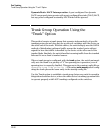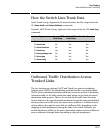
Port Trunking
Trunk Group Operation Using LACP
■ If there are ports that you do not want on the default VLAN, ensure that
they cannot become dynamic LACP trunk members. Otherwise a traffic
loop can unexpectedly occur. For example:
VLAN-1
(Default
VLAN)
VLAN-2
VLAN-1
(Default
VLAN)
VLAN-2
VLAN-1
(Default
VLAN)
VLAN-2
VLAN-1
(Default
VLAN)
VLAN-2
If the ports in VLAN 2 are configured to allow a dynamic trunk (and GVRP is disabled), adding a
second link in VLAN 2 automatically forms a dynamic LACP trunk and moves the trunk to VLAN-1
(the default VLAN), which creates a traffic loop in VLAN 1 between the two switches and
eliminates the link in VLAN 2 between the two switches.
Figure 12-12. A Dynamic LACP Trunk Forming in a VLAN Can Cause a Traffic Loop
Easy control methods include either disabling LACP on the selected ports or
configuring them to operate in static LACP trunks.
Spanning Tree and IGMP. If Spanning Tree and/or IGMP is enabled in the
switch, a dynamic LACP trunk operates only with the default settings for these
features and does not appear in the port listings for these features.
Half-Duplex and/or Different Port Speeds Not Allowed in LACP
Trunks. The ports on both sides of an LACP trunk must be configured for
the same speed and for full-duplex (FDx). The 802.3ad LACP standard speci-
fies a full-duplex (FDx) requirement for LACP trunking. (10-gigabit ports
operate only at FDx.)
A port configured as LACP passive and not assigned to a port trunk can be
configured to half-duplex (HDx). However, in any of the following cases, a
port cannot be reconfigured to an HDx setting:
■ If the port is a 10-gigabit port.
■ If a port is set to LACP Active, you cannot configure it to HDx.
■ If a port is already a member of a static or dynamic LACP trunk, you cannot
configure it to HDx.
■ If a port is already set to HDx, the switch does not allow you to configure
it for a static or dynamic LACP trunk.
12-25


















